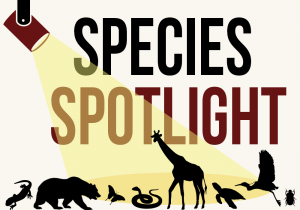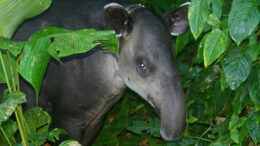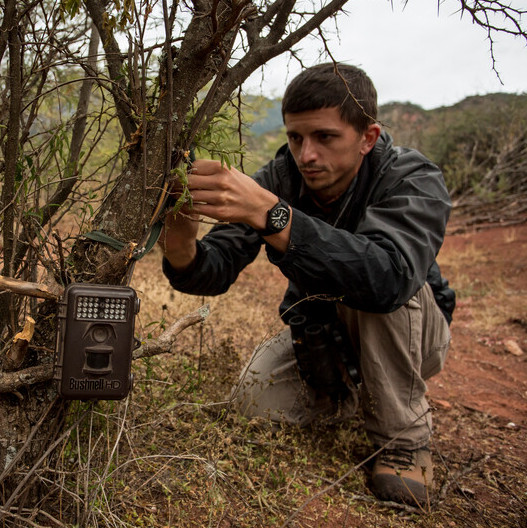Baird’s tapirs are known as the “gardeners of the forest” because they eat a diversity of plants, fruits and seeds. They disperse the latter in their dung, helping forests regenerate.
Species name:
Baird’s tapir (Tapirus bairdii)
Description:
 Tapirs are the largest neotropical mammals, with females reaching up to 600 pounds. They’re from the taxonomic order Perissodactyla, or odd-toed ungulates, meaning that they’re related to horses and rhinos. Unlike their cousins they have a short trunk called a proboscis, which they can use to grab foliage, seeds and other food. The largest seeds in tropical forests tend to be associated with slow-growing trees with dense wood, precisely the species of trees that sequester the most carbon. Large mammals like tapirs are the only animals capable of dispersing these seeds, and the reproduction of these trees depends to a significant extent on tapirs. This means that tapirs are not only important due to their roles as “gardeners,” but are also some of our strongest allies in our fight against global climate change.
Tapirs are the largest neotropical mammals, with females reaching up to 600 pounds. They’re from the taxonomic order Perissodactyla, or odd-toed ungulates, meaning that they’re related to horses and rhinos. Unlike their cousins they have a short trunk called a proboscis, which they can use to grab foliage, seeds and other food. The largest seeds in tropical forests tend to be associated with slow-growing trees with dense wood, precisely the species of trees that sequester the most carbon. Large mammals like tapirs are the only animals capable of dispersing these seeds, and the reproduction of these trees depends to a significant extent on tapirs. This means that tapirs are not only important due to their roles as “gardeners,” but are also some of our strongest allies in our fight against global climate change.
Where found:
From Mexico to Colombia, primarily in the remaining intact forests of the region.
IUCN Red List status:
Baird’s tapirs are classified as endangered. Experts estimate that the current population could contain as few as 4,500 mature adults.
Major threats:
Central America has lost massive tracts of forest during the past decade, much of it due to major roads that now bisect the range of Baird’s tapirs. The loss of habitat, combined with significant hunting throughout their range, has devastated the species and left the remaining tapirs in isolated subpopulations. It’s unclear if all these subpopulations are genetically viable, as the slow reproductive rate of tapirs makes it difficult for any population to rebound quickly.
Conservationists fear that they may lose even more habitat to climate change. Much of the species’ northern stronghold of the trinational Maya Forest has limited water during the dry season. Climate change may reduce the amount of available water in these areas even further and thus make the large, protected habitat unsuitable for tapirs.
Notable conservation programs:
The Baird’s Tapir Survival Alliance is an effort to build precisely the substantial, coordinated, long-term regional effort needed to save this species. BTSA members hail from Mexico, Guatemala, Belize, Honduras, Nicaragua, Costa Rica and Panama.
View this post on Instagram
My favorite experience:
One of my favorite personal experiences was while we were collaring tapirs in Indio Maiz Biological Reserve in Nicaragua. We were with a film crew that wanted to film tapirs, and we spent all day trying to track a tapir with a collar in order to film him, but somehow he kept evading us. At the end of the day, in frustration, I went in a canoe up the river by myself without any cameras, just to be 100% sure that the collar was working properly. I walked maybe 50 yards into the forest; there he was, standing in front of me, eating plants with the collar on. It was like getting home after a long absence and seeing my dog again.
I also had a recent sighting in Belize. We spent all day exploring a property we protect there. My colleague Jeremy Radachowsky and I set out alone to look around at some clearings we’d seen on a map and ended up finding a beautiful creek, filled with Morelet’s crocodiles and other wildlife. While we were watching the crocodiles, I saw a tapir head swim across the creek, some 50 yards away. We snuck up the edge of the creek to try to find it and ended up coming out behind a natural blind only about 5 yards from the animal. From that cover we got to watch him swimming around for at least 20 minutes. It was great to watch him like that, knowing we’d helped to protect his forest.
![]()


